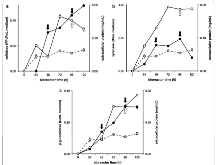Myceliophthora thermophila M77 utilizes hydrolytic and oxidative mechanisms to deconstruct biomass
Biomass is abundant, renewable and useful for biofuel production as well as chemical priming for plastics and composites. Deconstruction of biomass by enzymes is perceived as recalcitrant while an inclusive breakdown mechanism remains to be discovered. Fungi such as Myceliophthora thermophila M77 appear to decompose natural biomass sources quite well. This work reports on this fungus fermentation property while producing cellulolytic enzymes using natural biomass substrates. Little hydrolytic activity was detected, insufficient to explain the large amount of biomass depleted in the process. Furthermore, this work makes a comprehensive account of extracellular proteins and describes how secretomes redirect their qualitative protein content based on the nature and chemistry of the nutritional source. Fungus grown on purified cellulose or on natural biomass produced secretomes constituted by: cellobiohydrolases, cellobiose dehydrogenase, β-1,3 glucanase, β-glucosidases, aldose epimerase, glyoxal oxidase, GH74 xyloglucanase, galactosidase, aldolactonase and polysaccharide monooxygenases. Fungus grown on a mixture of purified hemicellulose fractions (xylans, arabinans and arabinoxylans) produced many enzymes, some of which are listed here: xylosidase, mixed β-1,3(4) glucanase, β-1,3 glucanases, β-glucosidases, β-mannosidase, β-glucosidases, galactosidase, chitinases, polysaccharide lyase, endo β-1,6 galactanase and aldose epimerase. Secretomes produced on natural biomass displayed a comprehensive set of enzymes involved in hydrolysis and oxidation of cellulose, hemicellulose-pectin and lignin. Furthermore, the participation of oxidation reactions coupled to lignin decomposition in the breakdown of natural biomass may explain the discrepancy observed for cellulose decomposition in relation to natural biomass fermentation experiments.
- Research Organization:
- Oklahoma State Univ., Stillwater, OK (United States)
- Sponsoring Organization:
- USDOE
- Grant/Contract Number:
- 06103-OKL; ZDJ-7-77608-01; 403090/2012-1
- OSTI ID:
- 1330731
- Alternate ID(s):
- OSTI ID: 1375956
- Journal Information:
- AMB Express, Journal Name: AMB Express Vol. 6 Journal Issue: 1; ISSN 2191-0855
- Publisher:
- Springer Science + Business MediaCopyright Statement
- Country of Publication:
- Germany
- Language:
- English
Web of Science
Similar Records
Hydrolysis of untreated lignocellulosic feedstock is independent of S-lignin composition in newly classified anaerobic fungal isolate, Piromyces sp. UH3-1
Integrative visual omics of the white-rot fungus Polyporus brumalis exposes the biotechnological potential of its oxidative enzymes for delignifying raw plant biomass







